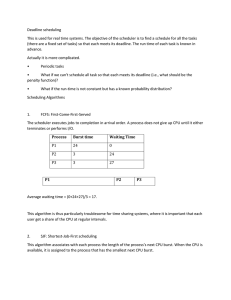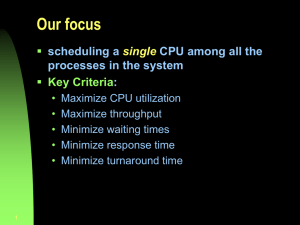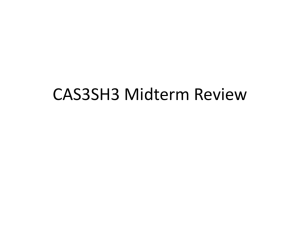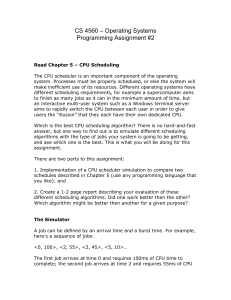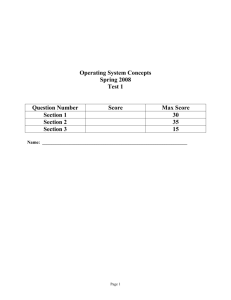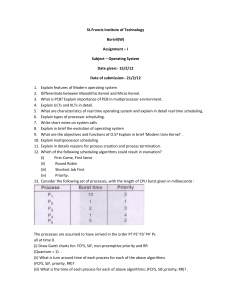Lecture 06 Operating System CPU Scheduling
advertisement
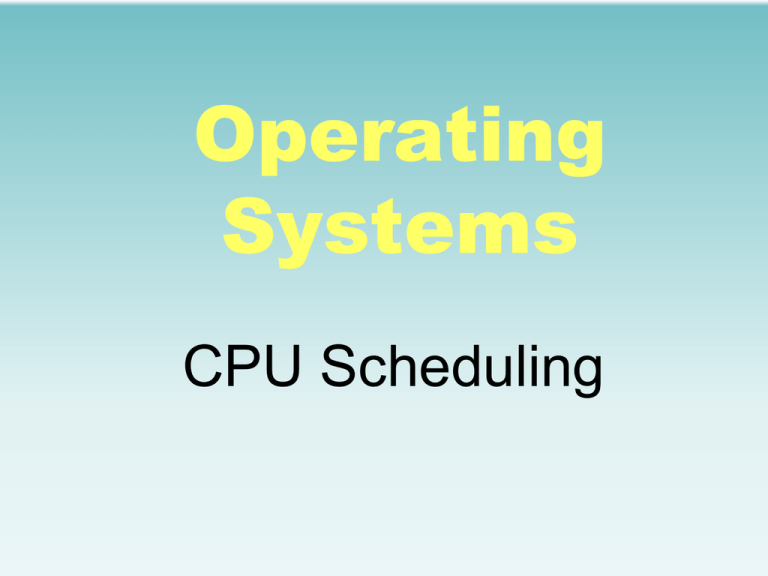
Operating Systems CPU Scheduling Agenda for Today What is Scheduler and its types Short-term scheduler Dispatcher Reasons for invoking scheduler Optimization criteria FCFS, SJF, SRTF, RR, Multi level Queues With Examples CPU Scheduling Scheduling processes in the ready queue Short-term scheduler Different types of schedulers Life of a Process Histogram of CPUburst Times CPU Scheduler Short-term scheduler Selects a process from among the processes in the ready queue Invokes the dispatcher to have the CPU allocated to the selected process Dispatcher Dispatcher gives control of the CPU to the process selected by the short-term scheduler; this involves: switching context switching to user mode jumping to the proper location in the user program to start (or restart) it Dispatcher Dispatch latency – time it takes for the dispatcher to stop one process and start another running. Typically, a few microseconds CPU Scheduler CPU scheduling decisions may take place when a process: 1. Switches from running to waiting state 2. Switches from running to ready state 3. Switches from waiting to ready 4. Terminates CPU Scheduler Scheduling under 1 and 4 is nonpreemptive. All other scheduling is preemptive. Scheduling Criteria CPU utilization – keep the CPU as busy as possible Throughput – # of processes that complete their execution per time unit Turnaround time – amount of time to execute a particular process Scheduling Criteria Waiting time – amount of time a process has been waiting in the ready queue Response time – amount of time it takes from when a request was submitted until the first response is produced, not output (for timesharing environment) Optimization Criteria Maximize CPU utilization Maximize throughput Minimize turnaround time Minimize waiting time Minimize response time FCFS Scheduling The process that enters the ready queue first is scheduled first, regardless of the size of its next CPU burst Example: Process Burst Time P1 24 P2 3 P3 3 Suppose that processes arrive into the system in the order: P1, P2 , P3 FCFS Scheduling Processes are served in the order: P1, P2, P3 The Gantt Chart for the schedule is: P1 0 P2 24 P3 27 30 Waiting times P1 = 0; P2 = 24; P3 = 27 Average waiting time: (0+24+27)/3 = 17 FCFS Scheduling Suppose that processes arrive in the order: P2 , P3 , P1 . The Gantt chart for the schedule is: P2 0 P3 3 P1 6 30 Waiting time for P1 = 6; P2 = 0; P3 = 3 Average waiting time: (6 + 0 + 3)/3 = 3 Convoy effect short process behind long process Shortest-Job-First (SJF) Scheduling Process with the shortest CPU burst is scheduled first. Non-preemptive – once CPU given to a process it cannot be preempted until completes its CPU burst. Shortest-Job-First (SJF) Scheduling Preemptive – if a new process arrives with CPU burst length less than remaining time of current executing process, preempt it—ShortestRemaining-Time-First (SRTF). SJF is optimal non-preemptive scheduling algorithm – gives minimum average waiting time for a given set of processes. Non-Preemptive SJF Process Arrival Time P1 0.0 P2 2.0 P3 4.0 P4 5.0 Gantt chart P P 1 0 3 7 Burst Time 7 4 1 4 P2 P4 12 16 Average waiting time = (0+6+3+7)/4 = 4 Preemptive SJF Process P1 P2 P3 P4 Gantt chart Arrival Time 0.0 2.0 4.0 5.0 P1 0 P2 2 P3 4 Burst Time 7 4 1 4 P2 5 P4 7 P1 11 16 Average waiting time = (9 + 1 + 0 +2)/4 = 3 Priority Scheduling A priority number (integer) is associated with each process The CPU is allocated to the process with the highest priority (smallest integer highest priority). Preemptive Non-preemptive Priority Scheduling SJF is a priority scheduling where priority is the predicted next CPU burst time. Problem Starvation – low priority processes may never execute. Solution Aging – as time progresses increase the priority of the process. Round Robin (RR) Each process gets a small unit of CPU time, called time slice or quantum, which is usually 10100 milliseconds. After this time has elapsed, the process is preempted and added to the end of the ready queue. Round Robin (RR) If there are n processes in the ready queue, the time quantum is q, and context switch time is tcs, then no process waits more than (n-1)(q+tcs) time units Used in time-sharing systems where response time is an important performance criteria Round Robin (RR) Performance q large FCFS q small q must be large with respect to context switch, otherwise overhead is too high. Round Robin Example Process Burst Time P1 53 — 33 — 13 P2 17 P3 68 — 48 — 28 — 8 P4 24 — 4 The Gantt chart with quantum 20 is: P1 0 P2 20 P3 37 P4 57 P1 77 P3 97 117 P4 P1 121 134 P3 P3 154 162 Round Robin Example Process Turnaround Time P1 P2 P3 P4 134 37 162 121 Waiting Time 134 – 53 = 81 37 – 17 = 20 162 – 68 = 94 121 – 24 = 97 Average waiting time = 73 Average waiting time for SJF = 38 Typically, higher average turnaround than SJF, but better response. Quantum vs Context Switch Process Time = 10 Quantum Context Switches 12 0 6 1 1 9 Multilevel Queues Ready queue is partitioned into separate queues: - foreground (interactive) - background (batch) Each queue has its own priority and scheduling algorithm: - foreground – RR - background – FCFS Multilevel Queues Scheduling must be done across queues. Fixed priority scheduling; i.e., serve all from foreground then from background. Time slice – each queue gets a certain percentage of CPU time, e.g., 80% to foreground in RR and 20% to background in FCFS Multilevel Queues Multilevel Feedback Queues A process can move between the various queues; aging can be implemented this way. Multilevel-feedback-queue scheduler defined by the following parameters: Number of queues Scheduling algorithms for each queue Multilevel Feedback Queues Method used to determine when to upgrade a process Method used to determine when to demote a process Method used to determine which queue a process will enter when that process needs service Multilevel Feedback Queues
